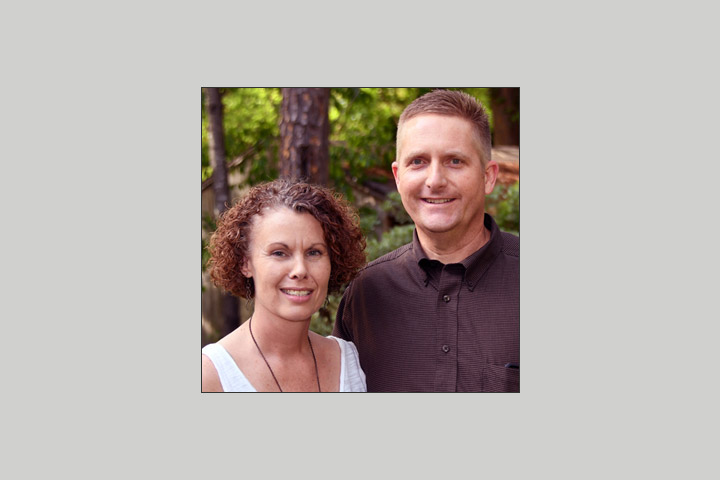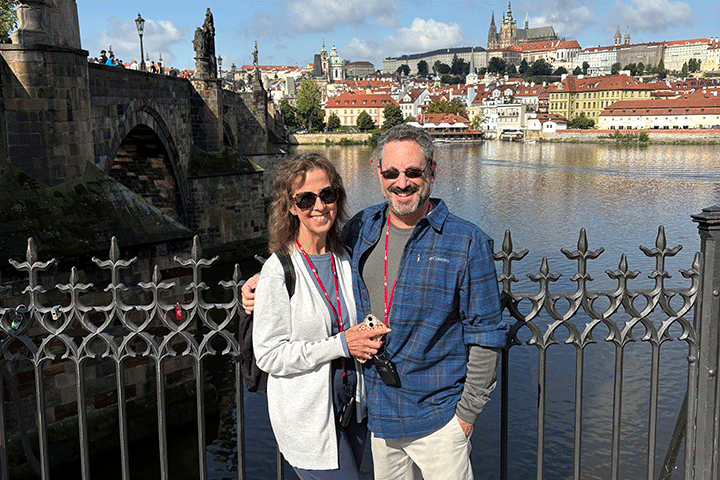A Second Opinion Leads to a New Treatment Plan

- Blocked bile duct causes symptoms that lead to pancreatic cancer diagnosis
- Surgery plan changed by getting a second opinion
- New plan includes neoadjuvant chemotherapy, then surgery
- Post-surgery chemo and radiation
- Adjusting to the new normal
I was 47, in good physical condition but I needed to lose about 25 pounds, so I started working with a personal trainer, Carolyn McCoy, in early 2018.
It was in early April and I was doing some new core exercise when I thought I might have pulled a stomach muscle. But that weekend I noticed that my stool became a light gray color. I mentioned this to my trainer, who refused to train me until I saw a doctor.
When I saw my family doctor he thought it might be a pulled muscle but ordered some basic tests just to rule out more serious problems. I was feeling worse by the day. That Sunday I noticed that my body and the whites of my eyes were yellow. On Monday morning, my doctor’s office informed me I had an appointment on Tuesday with Dr. Afsar Waraich, a gastrointestinal specialist. My bilirubin count was high and I was jaundiced, indicating bile was not draining out of the liver through the pancreas. Dr. Waraich ordered a battery of tests, including CT and ultrasound scans. When I went back for my test results Thursday, I was feeling bad enough that I was willing to do about anything. The doctor indicated I probably had a cyst in the head of the pancreas that was pinching the bile duct. He ordered an ERCP for me at Medical University of South Carolina (MUSC) in Charleston for the next morning.
On the long drive from Aiken to Charleston I talked to a nurse about the procedure and asked if the cyst would be removed. Her noncommittal and vague response was the first indication that something more serious might be going on. As I was waking up from the procedure, I heard the doctor tell my wife, April, that I had adenocarcinoma—pancreatic cancer. The tumor was located in the head of the pancreas and was labeled resectable; later scans revealed no indication of metastasis to other organs.
Making a Treatment Plan
On May 2, 2018, we met with Dr. Katherine Morgan, an experienced pancreatic surgeon at MUSC. Dr. Morgan mentioned the option of receiving chemo treatment prior to surgery but indicated that the medical professional jury is still out on which one is best to do first, surgery or chemo. Because my tumor did not impact any blood vessels it seemed the logical thing to do was get it out before it grew or spread, then do the chemo. Dr. Morgan indicated that neither decision was really right or wrong and she was more than willing to accommodate the surgery first. A surgery date was set for May 21 for my Whipple procedure. We returned home on May 3rd feeling like we had a plan.
A Second Opinion Changes Everything
April registered with PanCAN, and through an internet search found that the Mayo Clinic in Jacksonville, Florida, specializes in treating pancreatic cancer. She suggested that I consider getting a second opinion and emailed Mayo, followed by a phone call. We were given an appointment with Mayo surgeon Dr. John Stauffer on May 9. That morning, at Mayo’s request, we collected all my reports and a CD of all the images/scans to date, and drove the four hours to Jacksonville. On the way, I received a phone call from Mayo asking if we could arrive sooner so the medical team could review the images. We delivered the image CDs to the office about 1:00 p.m., then sat in the hall and ate lunch.
When we met with Dr. Stauffer, he and his team had already reviewed the images and reports. Dr. Stauffer reinforced most everything Dr. Morgan had already told us. He added that the tumor seen today is not the one that will kill you—the microscopic cells that are not removed or killed now are the ones that grow years from now, and are the ones that kill you. Dr. Stauffer indicated that he could perform the Whipple in the traditional open manner, or laparoscopically, and even if the tumor was around the veins in the pancreas, he could reconstruct them if necessary.
He then asked what we had been told by my oncologist. We indicated that we had not yet met with any oncologist, which did not set well with him. He made arrangements for us to immediately see Dr. Pashtoon Kasi (now at WeillCornell in New York).
When we met with Dr. Kasi he reiterated Dr. Stauffer’s statement that the tumor seen today is not the one that will kill you. Dr. Kasi asked me several questions about my family history, drinking, tobacco use, and other potential causal factors. We discussed the five different cancers that my mom has had: breast cancer, inflammatory breast cancer, uterine cancer, squamous cell carcinoma on her leg, and most recently a brain cancer. He became convinced that my only risk factor for cancer is my genetics. Thus, he strongly recommended the chemo cocktail called FOLFIRINOX, a DNA-damaging drug combination.
While Dr. Kasi’s scheduler checked availability for my first chemo appointment I went for some blood tests. While I was waiting the scheduler called and told me that they just had a cancellation for a five-hour chemo treatment the next morning at 8:15 a.m. The chemo training session provider was also available at 7:30 a.m., and the genetic testing counselor was available at 2:30 p.m. after the chemo. It was all lined up, something everyone indicated never happens. Now all I had to do was deal with the whiplash we were experiencing of going from a planned surgery on May 21 at MUSC, to doing chemo first at Mayo and postponing the surgery. Standing at the desk, I took all three appointments, knowing I could still change my mind Thursday morning.
I spent some time Wednesday night talking and texting with friends about the sudden decisions that had to be made. Everyone suggested going with the recommendation of Mayo since they are the experts. I felt nervous, but pretty good with the decision to do the FOLFIRINOX treatment first. I realized that I was not reducing or eliminating treatment options by choosing a path that had been laid out like a red carpet for me in a matter of hours. I felt like the door had been opened as a boot was firmly applied to my backside. All I had to do was go through with the plan.
Treatment Begins
During the first chemo treatment Dr. Kasi came by to check on me. Having an IV in my arm for five hours was not pleasant. It left a bruise that lasted for a month. Dr. Kasi’s scheduling assistant made arrangements for me to have a port installed on May 23, the day before my next chemo treatment. While I was nervous about having the port installed, I didn’t want the IV again.
After the chemo, we met with the genetic testing counselor. I knew that my mother underwent genetic testing in 2013, after her first bout with breast cancer. She was able to scan and email the results to me in time for this meeting. Her results showed that she does not have the BRCA2 mutation. So there was no obvious genetic link between her cancer and mine.
I underwent pharmacogenomic testing, and the results showed that I was sensitive to some of the drugs in my chemotherapy. The Mayo oncology pharmacist recommended a dose reduction in some components of FOLFIRINOX due to my results. Without all the tests, the standard FOLFIRINOX chemo dosage would have been more than my system could have handled. The details of my case even garnered a journal article in Frontiers in Pharmacology.
With prescriptions to combat nausea and diarrhea, we finally returned to Aiken. Mayo worked with local oncologist Dr. Mark Keaton (now based in Hawaii) so I could receive chemo treatments locally, in his Augusta, Georgia office every two weeks. After the sixth chemo treatment, while I was still in his office, I had a reaction to the oxaliplatin. We discontinued the drug after that.
Time for the Whipple
Approximately six weeks after my sixth neoadjuvant chemo treatment, on August 22, 2018, I had the laparoscopic Whipple at Mayo, with Dr. Stauffer. I remember waking up as they were wheeling me into my hospital room. A nurse asked me if I wanted to walk around. It must have been the medication talking because I agreed and did a lap around the room before returning to bed. Over the next few days I walked numerous laps in the hall. The most difficult hurdle was achieving the required minimum on the device that measured my lung capacity. I also discovered that adult diapers were very necessary and should have brought them with me to check-in.
Minus the oxaliplatin, I received four more chemo treatments, beginning about eight weeks after surgery. Carolyn McCoy (now certified by the Cancer Exercise Training Institute) researched exercises for cancer patients and kept me safely pushing my physical limits before and after surgery. I always felt better after some exercise no matter how much I had to mentally push myself to start. I’m convinced that exercise helped me tolerate the chemo and helped the chemo perform better. From an engineering perspective, I felt the exercise was helping to push some blood through the difficult places that needed the medicine it was carrying. I also believed that the exercise helped carry away the waste and impurities faster so I could recover faster. Dr. Stauffer indicated that the tumor was mostly a dead mass when he removed it, indicating that the chemo got in and did its job.
Post-Recovery, Radiation, and More Chemo
Starting in January of 2019, I began a series of 28 radiation treatments coupled with a different chemo drug. I learned that while chemo treatments are fairly cookie cutter, radiation treatments are more like surgery—not all facilities are equal. During my radiation treatments I was able to stay with the Chase family, friends of a friend of mine. I was looking for an Airbnb for those six weeks but was really thankful to my friend who introduced us. Being able to stay in a home during these treatments made everything so much easier. I can’t thank the Chase family enough for having me stay with them during this time.
Life Now
My current care is limited to tests and scans every three to four months. My next check-up will be in October just before my wife and I participate in the PurpleStride 5k run in Jacksonville.
I exercise several times a week. I mostly eat what I want, but I have learned that no amount of Creon can help me with some foods. I take an over-the-counter probiotic and a full dose of fiber every day. I vary between needing two to three Creon (24,000 cu) each day. Some days are definitely better than others. Early mornings are the hardest as I try to get around and leave the house for work. Some days my digestive system makes it hard for me to get out of the house. Other days, I almost feel like a normal person.






